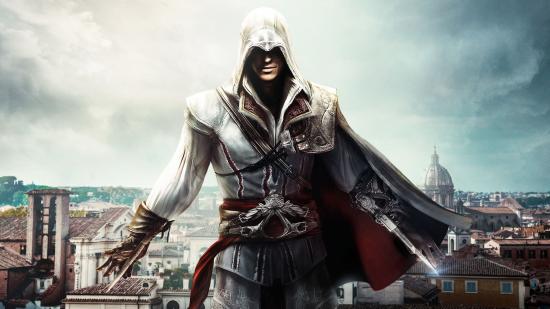Our Verdict
In spite of some graphical issues, Assassin's Creed: The Ezio Collection on Switch holds up well enough for any fan of the series to enjoy a great, portable city break full of many, many murders. It's not ideal, but how many big, open-world games are ideal on Switch?
There’s a specific magic to playing open-world videogames on a handheld. Even if you’re just sitting on the couch, the freedom of a different world in the palm of your hand is something special. I think that it’s key to the success of the Nintendo Switch. Not just launching with one of the best open-world games in recent memory, but also having a steady flow of new worlds to explore, as well as the old, familiar worlds to go back to.
Assassin’s Creed is like having a very big meal and then doing everybody’s washing up. Lots of good stuff, lots of chores. Good chores, mind you, that give the same satisfaction as cleaning the hob. When I played Assassin’s Creed III on the Switch, I was compelled to complete everything. I got every last collectable. That’s ridiculous for two reasons: not only does it take ages to get all those collectables, but ACIII is also not very good. But with the ease of access to this world, the mindless collectathon that is most AC games is actually more enjoyable. I found a new love for a not-great game on Switch because of the console itself. And these games need to be reviewed with that in mind.
This happened again with the Rebel collection, which features Assassin’s Creed IV: Black Flag (a great game) and Assassin’s Creed Rogue (a better game than people say), both of which thrive on Switch. Sailing through endless seas is a wondrous experience on a portable. It’s just so exciting. It’s the stuff I got excited about as a kid. It’s why I picked up a PSP and GTA Liberty City Stories when I was still a pre-teen. It’s something I always wanted, but could never quite have. Now I do have it, and I couldn’t be happier. But has the gimmick worn off? Does that magic raise the Ezio collection to new heights? Do three of the most beloved AC games hold up?
Well, sort of… AC2’s Florence is colourful, but in an incoherent, two-dimensional way. Brotherhood’s Rome is red, massive, and slick. Revelations’ Istanbul is golden, dense, and layered. These places exist loudly, especially in the latter two games. It feels like going on holiday as a kid, but this time your parents aren’t there. What I’m saying is that virtual murder and digital tourism intertwine sublimely even when the graphics can’t quite cut it. There is a vibrancy, an aura, a power to these places. So for all my criticisms that follow, the dream of a portable world is realised well enough for it to be exciting and satisfying. And that means the collection is a success.
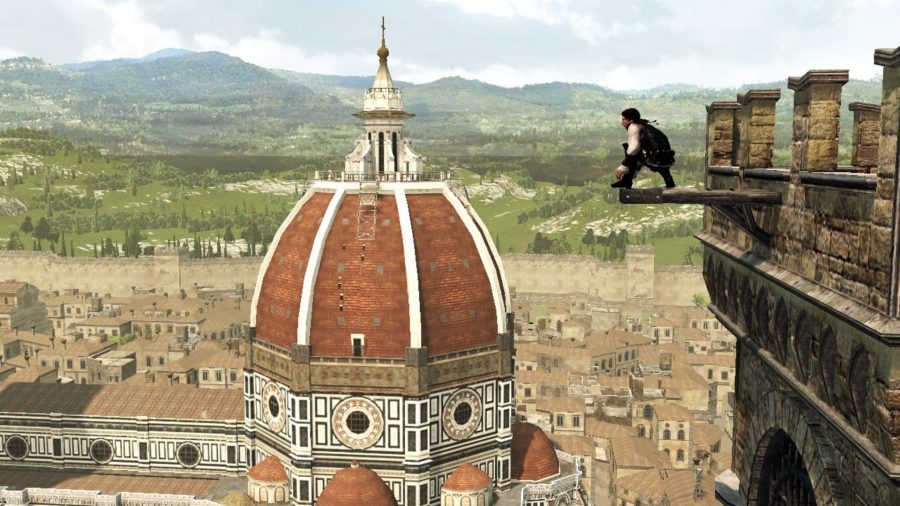
ASSASSIN’S CREED II
The first Ezio game is quite difficult to go back to all these years later. It has a slow introduction, sometimes irritating parkour, and overall serves as an excellent reminder of how much better the Assassin’s Creed games have become. It still has a great, ridiculous story and some charming characters, but it all feels much older than I thought it would. As a very big fan of the games, I’m more than happy to suffer through this, but I can feel Assassin’s Creed II’s age throughout.
That’s not really a criticism, more a warning. The whole point of the collection is to play old games in a better form. Of course, playing a 13-year-old game will make you think of how far games have come. That’s how it works.
This is still the same excellent game from 2009 that lets you explore detailed recreations of Florence, Venice, Forlì, San Gimignano, and Monteriggioni. And I think that’s its main selling point (the same applies for any early Assassin’s Creed game). Running around, ticking boxes, picking stuff up, fighting, running around some more. It’s all just furniture in the big, gorgeous room that is the world and the story sewn into it. So don’t worry, that’s still here.
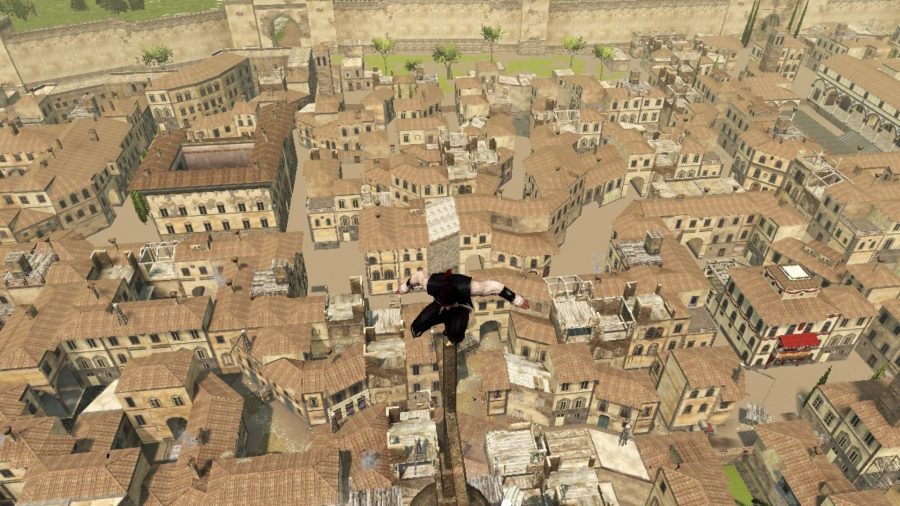
But, while the world is there, it doesn’t always look quite right. Of course, old games etc., but there are some strange graphical glitches throughout the collection. For something designed to be the definitive way to play these three games, it doesn’t often feel like it.
From the top, then, literally and figuratively – the first thing I did in open-world Florence was climb to the top of the tallest building I could see. As I climbed, I felt the same thrill I did when I first played this game when I was eleven. It still gave me that feeling of freedom to conquer the map in a way that, back then, I had never seen in a game before.
I’ve seen it a million times now, and it still gets some strange excitement whirring. But, once at the top, I looked out and saw a disappointing view – repeated textures for the streets and alleys in the distance, half the river reflecting light but the other half not, some buildings appearing to glisten in sunlight during the nighttime. This should be the game’s party piece, and it was just ok.
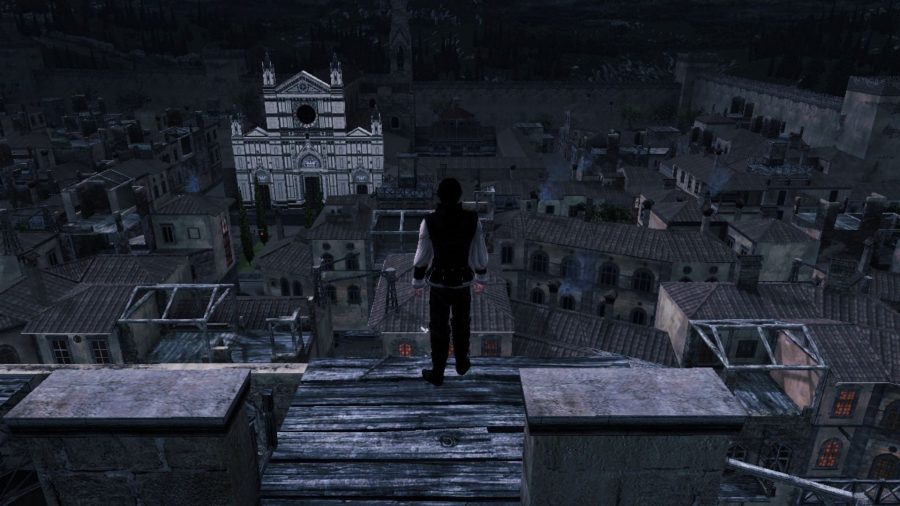
There are a few other moments like that. For example, while climbing, as the camera pops over the top of a building and reveals the skyline, there’s a split second until everything appears in the distance. It’s minuscule but noticeable. This happened to me running through the streets too, turning a corner and seeing a strange sudden bit of movement, like the buildings were pulsating, just because the game was a fraction too slow loading in higher-res textures. Then there’s the aliasing, these strange white lines that appear in the distance, moving and shimmering. That’s everywhere, ignorable, but still occasionally jarring.
I could go on about the graphical presentation of the first game in this collection, but it adds nothing at this point. The most important thing is that Assassin’s Creed II definitely looks better now than it did when it first came out. Colours pop, rather than having that washed out beige filter that plagued noughties games; faces are more expressive, even if they still look a bit wacky; and the sky and the lighting are vastly improved. And outside of Florence and Venice, in Monteriggioni or San Gimignano, the issues are far less severe, even if they’re still present. But the cities are where you’ll spend most of your time, and it’s just a shame that Ubisoft didn’t iron out every wrinkle.
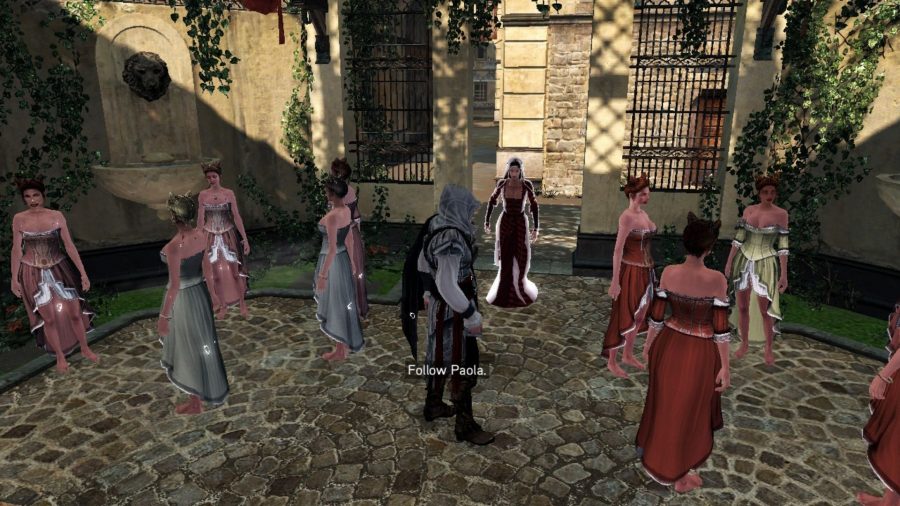
Again, though, this is more of a strong warning than an all-out criticism. Assassin’s Creed II is a great old game, and this is the only way to play it on the Nintendo Switch, and it’s a good enough way to do so. Running through tight Venetian streets while on the bus or lying in bed is a real treat. If that’s what you want, that’s what you’ll get. Rejuvenating Monteriggioni is still a lovely distraction on the side, riding through the fields of Tuscany with the towers of San Gimignano in the distance is still magical, and, overall, there is still a lot to enjoy.
Assassin’s Creed Brotherhood
The opening sequence of Brotherhood is a weird mix of good and bad. It’s immediately obvious how much slicker the game is than AC2, with more fluid combat and climbing. There’s also a lot less input lag, and everything just looks prettier. But the busy escape from the Vatican also doesn’t perform very well. There were a lot of frame rate issues on handheld, and possibly resolution dipping. I can’t be certain, but when I was moving at speed while being chased by enemies, everything seemed to become blurrier, most noticeably on the edges of Ezio’s outfit. If these are the sacrifices that need to be made to get it on a handheld, so be it. But there were definitely sacrifices.
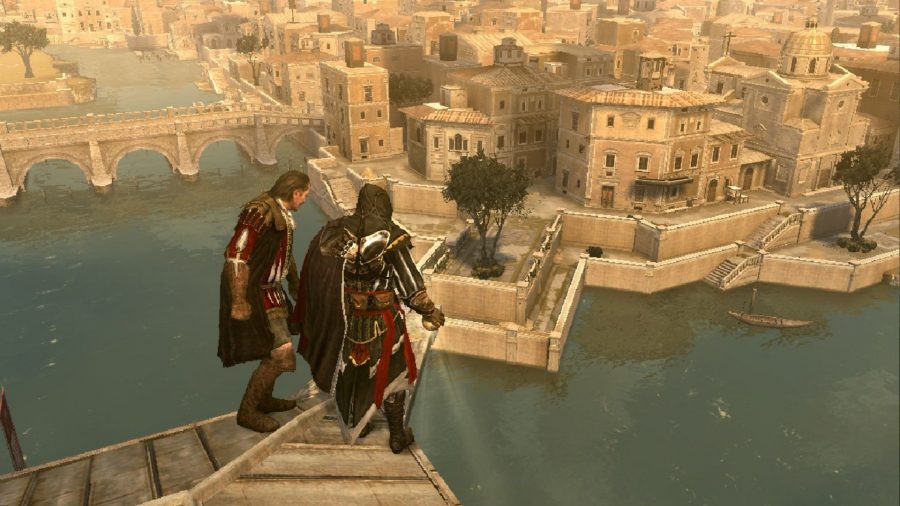
Once everything gets going, however, it’s clear how much better the game is than its predecessor, and the worst performance issues seem to be reserved for the more intense, set-piece moments. A few things have changed. Ezio is now the best murderer in the world, with fights becoming much more fluid thanks to execution streaks (yes, that’s the actual in-game name). The opening is also a lot more cinematic, as Monteriggioni is laid siege by enemies, cannonballs fire, citizens scream, and it feels bombastic. Graphical issues aside, that dramatic feeling is there on Switch.
Then there’s Rome, which is Brotherhood’s key. It is so massive and sprawling that it’s still impressive today. The first sight of it brought so many memories rushing back, from the different characters to various tombs that I raided years ago. Again, there are a handful of graphical issues, but the higher quality of textures and animation make sure the game has more graphical depth, and it feels more like a real place.
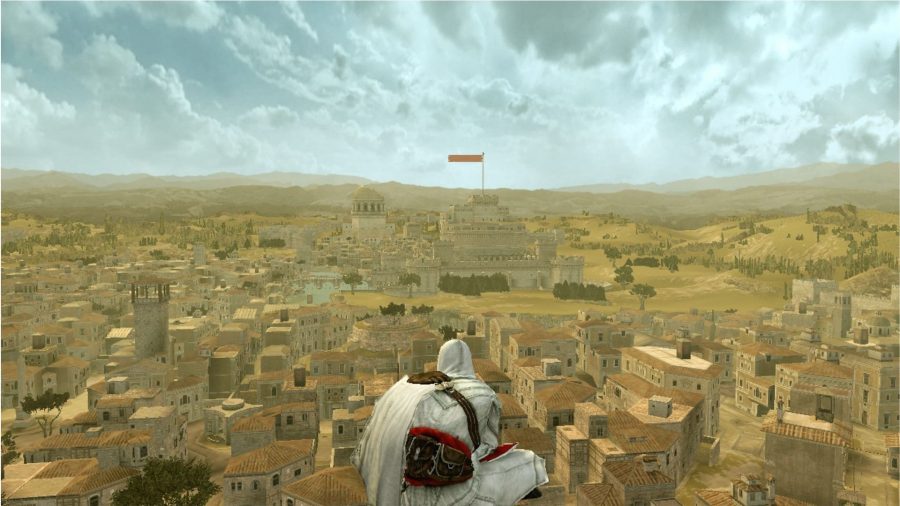
Playing these games one after the other is great. Seeing Ezio age and change as a character is rewarding, and he’s the only consistently written part of the trilogy (most of the modern-day stuff has such bad dialogue I want to turn the sound off). Brotherhood is such a confident game, starting straight where AC2 left off, and fleshes out Ezio’s character in meaningful ways. There’s also faster combat, slicker climbing, and a better location which make it a much more enjoyable experience.
Assassin’s Creed Revelations
Onto Revelations, then. The first thing that I notice is that it feels much more sci-fi. There are throbbing synth arpeggios over a cinematic recounting the modern-day events of the previous two games, and once we actually get control of a character, we are Desmond, stuck in the Animus. It feels like simple, proper sci-fi, à la The Matrix. It’s shallow but confident, which I quite like.
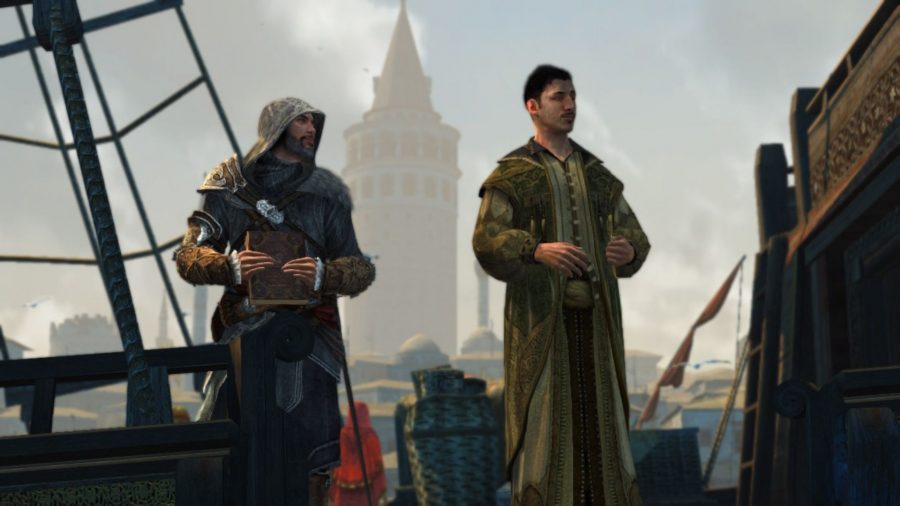
Once that’s done, we jump to the past, and the game feels very AAA, showing so much prestige. A list of every Ubisoft studio that worked on the game in the opening credits goes on for a comically long time, and then there’s a slick, gorgeous animation introducing where Ezio is in his older age. This is clearly a game made back when Assassin’s Creed was at the height of its powers (a time rivalled only by the most recent AC RPG trilogy), and the game itself is much more interesting than the previous two in terms of writing, with an ageing Ezio delivering a more nuanced character.
It’s still all about murder, but this time with bombs. There’s also a wild amount of items to collect and either combine into strange concoctions or just horde and sell. When you loot a body, the money you gain flashes up in the middle of the screen, followed by a list of strange stuff like phosphorous and salt of Petra. This shout of ‘look how much stuff is in this game!’ is something that has plagued the series ever since. But Revelations is the first game in the series that feels a little too bloated with stuff (yet it’s also the shortest of the three games in the collection).
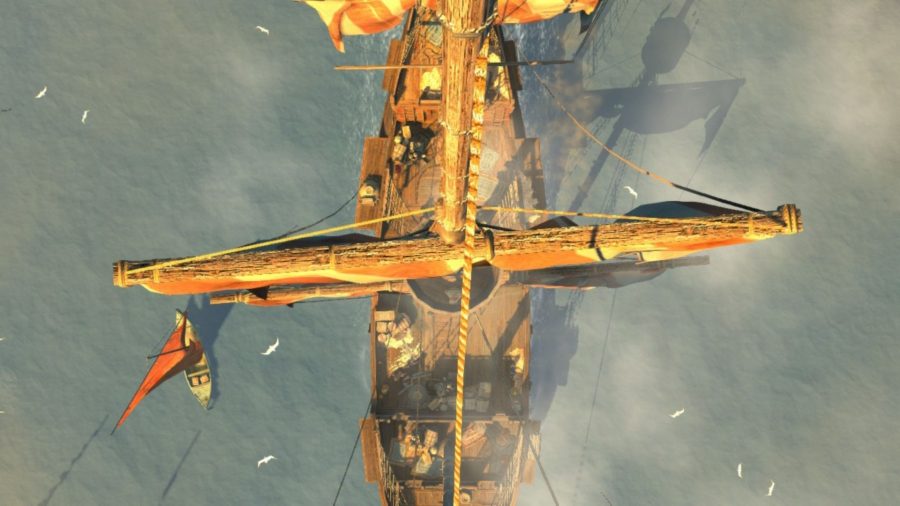
Ignoring that strange tower defence mini-game, the gameplay is just as before, but tweaked a little here and there for a slicker ride. There’s always the same foundation with these pre-RPG games, but Ubisoft just bolts on extra limbs to make them feel different enough. This time, the extra limb is a hook blade, an extension of your arm that makes climbing even quicker.
The world is gorgeous, and my favourite of the three to explore. The issues with draw distance, pop-in, and the level of detail on faces and textures still persist, but they seem to do so similarly across all three games. The amazing, dense streets of Constantinople are vibrant and warm, with gorgeous turrets dotting the skyline and the Bosphorus strait splitting its two sides, and it’s the best of the three games at creating a sense of place.
The fact that graphical issues don’t get worse with the slightly more demanding titles is great. AC2 looks and feels much older than I expected, but going through the trilogy is a definite move upwards, as facial animations and the general texture and depth of the graphical presentation improve steadily without diminishing performance.
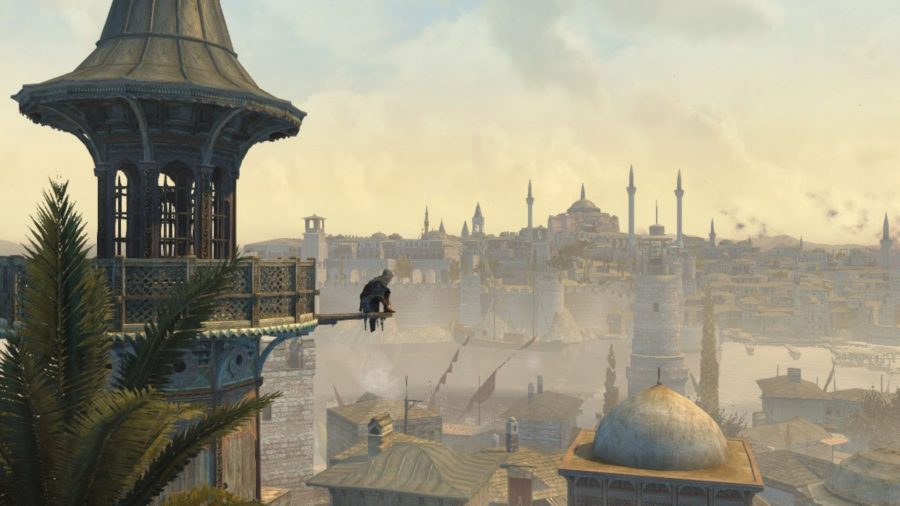
So that brings me back to my first thought. I’ve played so many open-world games on Switch, simply enamoured by the fact that I could do it portably. The Witcher 3 looks really nasty on Switch, but I completed it. The Outer Worlds looks like play-dough on Switch, but I completed it *twice*. If the game is good, is the graphical sacrifice always worth it for me?
Maybe, I don’t know. But in terms of the Ezio collection, the answer is: yes, definitely. When I was younger, I went to Florence with my parents, and they were surprised I kinda knew my way around. It was because I had spent so much time in that place virtually. These settings are so deeply rooted in me from experiencing them in my most formative years. And at that exact same time in my life, all I wanted was to have these open-world experiences on a portable system.
The power of both of these decade-old, childish feelings combining right here and now is very hard to explain. That power is there because of deeply personal experiences, but these are experiences that I’m sure many people have had too. If you love these games, it is so nice to have them with you wherever you want to go, especially if the best you could get at the time was a half-baked portable spin-off of GTA.
